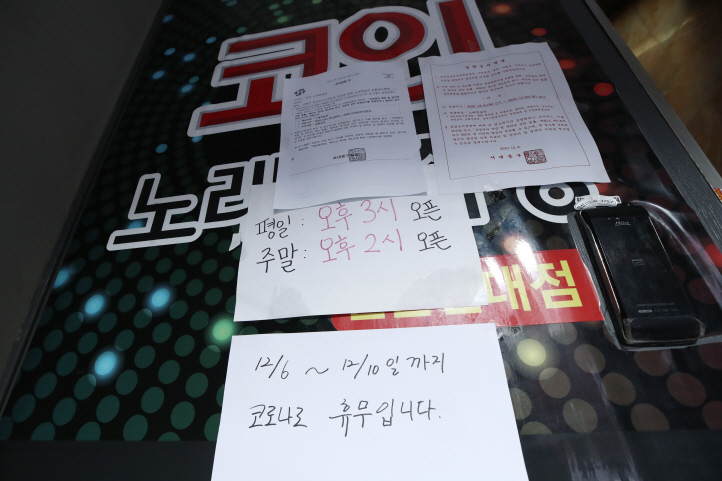
|
|
▲ There is a closing notice in a karaoke room in downtown Seoul. yunhap news |
[에너지경제신문 이원희 기자] The Korea Development Institute (KDI) diagnosed that the service industry’s sluggishness is intensifying due to the re-proliferation of a novel coronavirus infection (Corona 19).
On the other hand, the manufacturing industry evaluated that the gap by industry was widening as the improvement trend continued. KDI made this announcement in the’January Economic Trend’ released on the 10th.
◇ “Consumption sharply contracted due to deeper corona spread”… December credit card sales 16.2%↓
KDI pointed out, “Since mid-November last year, the service industry is intensifying due to the nationwide re-proliferation of Corona 19 and strengthening quarantine measures.” Last month’s economic trend pointed out that there is a possibility that the economy will contract, centered on service consumption. In this month’s economic trend, the service industry’s sluggishness is intensifying, so the possibility of a contraction has increased.
Shinhan Card’s estimated credit card sales for December fell 16.2% compared to the same month last year, recording a decline similar to March (-16.5%) when the first coronavirus pandemic occurred.
Credit card sales declined only 2.4% in October and 4.2% in November, respectively, but it is estimated that the decline rapidly expanded as the social distancing in the metropolitan area increased to 2.5 stages in December.
The December consumer sentiment index also fell 8.1 points from the previous month to 89.8. Earlier, the consumer sentiment index in November of last year was 97.9, the highest since January of last year (104.2) when the Corona 19 occurred in Korea, but it fell back in a month.
KDI said, “As the spread of Corona 19 intensified in December of last year, it is judged that consumption has shrunk significantly, such as a sharp drop in credit card sales and a drop in consumer sentiment index.” He predicted, “(from the end of December) there is a possibility that the consumption sluggishness, mainly in the service industry, will intensify as quarantine measures such as prohibition of gatherings of more than 5 people and business restrictions in some service industries are strengthened.”
◇ Continued recovery in the manufacturing industry… “Improved flow sustainability”
The manufacturing industry continued to recover as durable goods consumption, facility investment, and product exports increased simultaneously.
In November last year, durable goods consumption increased 12.8%, maintaining a good trend, and facility investment also recorded an increase of 5.7%, higher than the previous month (-0.9%), mainly for machinery. In particular, KDI diagnosed that capital goods imports in December, a leading indicator of facility investment, increased 23.3%, showing the possibility of continued investment improvement in the future.
Exports continued to recover in the fields related to information and communication technology (ICT). According to the Ministry of Trade, Industry and Energy, in December last year, exports recorded 54.1 billion dollars, an increase of 12.6% over the same period last year. The daily average export value, taking into account the number of working days, also increased by 7.9% to $2.14 billion, increasing both total and daily average exports for two consecutive months following November. Total exports increased for the second consecutive month in 25 months, and this is the first time in 26 months to show a double-digit growth rate. By item, semiconductors (30.0%), displays (28.0%), and wireless communication devices (39.8%) showed remarkable growth.
KDI analyzed that “the cyclical fluctuation of the leading index has recently risen and the semiconductor-related indicators have maintained a good trend, suggesting the possibility that the manufacturing industry will continue to improve.” However, KDI pointed out that “the mining industry continued to increase, mainly on exports, but the service industry continued to be sluggish and the gap between manufacturing and service industries widened.”
